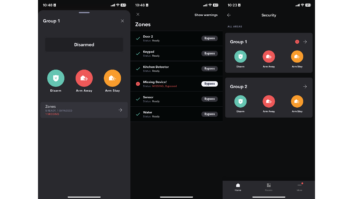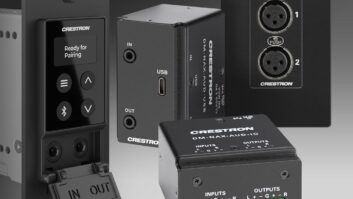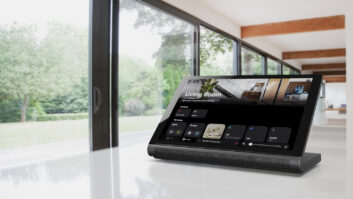During the New York stop on Crestron’s three-city CTP Summit tour last month, the Rockleigh, NJ-based AV products manufacturer spent an hour previewing many of the products that will be introduced by the end of the winter season. Following a big year dominated by its Digital Media NVX HDR video-over-IP (with zero latency) launch, Crestron’s 2018 plans promise even more innovations, including Horizontal Sheers automated window blinds, the addition of video control via Pyng, two new remote controls, and more. Leading the presentation was Doug Jacobson, Crestron’s director of residential technology.
Horizontal Sheers
First up was that new shades product called Horizontal Sheers, which can both darken the room and create privacy or let in diffuse light at other times without the need for both a blackout shade and sheer shade. “Sometimes you want to double the sale by selling both,” Jacobson said, “but in other projects it might not work because it blows out the budget.”

Once the Sheers go down, horizontal ribs can be turned 90 degrees and they let more natural light in. The line will be available this winter.
DM XiO Director
According to Jacobson, XiO Director is a major milestone in the NVX product line. The way he explained it, with an NVX system, each node on the network is an IP address unique to your programming. (In reality, you don’t always have to address all of the encoders and decoders; it can just be the decoders.) But the point is that as your NVX system gets larger and larger, you’ve got more and more devices that your program is responsible for managing.
For typical networks, NVX can get the job done and is easy to configure, Jacobson said. But when the project gets really large—say, with 40-200 end nodes—programming can become a little more challenging. Each one of these devices (or at least half of them—the decoders) takes up an IP ID in your program, so you’re limited. You might need to start breaking out into a separate program. XiO Director alleviates this limitation by creating a software-defined matrix.
Whereas in a traditional DM system, you’ve got one box responsible for routing everything between the inputs and the outputs, XiO Director creates that virtually for your network. Now you have a single device that you’re interfacing with instead of many devices. So, in a system with 200 nodes, rather than dealing with 100 or even 200 devices in your program, you’ll deal with a signal device in a more traditional design (one input to one output). It also creates a unified web interface for all of the individual boxes on a dealer’s network, as well as providing real-time remote management and troubleshooting. The web interface shows you exactly where everything is routed at all times. It will show you if a device has a problem or is offline. You can do live routing from there as well. You no longer have to use Crestron’s Toolbox. Instead, you point your web browser at the XiO director and have all control in one location.
Available this January, DM XiO Director comes in three “flavors.” One unit is capable of 80 endpoints, another 160 endpoints, and the third is 1,000s of endpoints.
DM 4KZ
To solve the HDR bandwidth limitations of Crestron’s 10-year-old Digital Media platform, the company has developed DM 4KZ. But first, a little backstory. Why couldn’t dealers just send a “pure” 4K signal over existing DM? “With HDBaseT you get about 9Gbps per second of bandwidth, which is fine for 4K30, 4K60 4:2:0,” Jacobson explained. “Once you start adding HDR, 4K60, and 4:4:4, however, you really have a bandwidth requirement of 18Gb. Now that you have more and more sources out on the market pushing HDR content, we needed to find a solution.”
The obvious answer, Jacobson said, was to compress the signal, and that was already being developed in the market with a lightweight 2:1 compression ratio called DSC. “It’s visually lossless. It’s a standard. And it’s not something that Crestron invented,” Jacobson said. “There are lots of vendors making chipsets, but it’s not easy to enable DSC compression. Even the best ones on the market—the ones we’re working with—haven’t figured it out yet.”
When we started developing DM 4KZ, they realized that if they wanted to be able to ship it as soon as they wanted, they would have to do a lot of the work themselves. “We took the chipset from the vendor, ripped out the software, and rewrote it from scratch,” Jacobson said. “I don’t want to make that sound like an easy task. In reality, it’s not. The fact that Crestron’s been doing Digital Media—digital video—for the past 10 years, is the reason why this has been possible. And you can believe that we’ve patented that.”
So, DM 4KZ offers 4K60 4:4:4 HDR that works with the existing DM infrastructure. “You can mix and match 4KZ with existing DM products, and over time we’re going to be releasing 4KZ products that are designed to replace existing 4K products at the same price. No price increase,” Jacobson said.
DM 4KZ products will begin rolling out early next year, first with HDMI input cards, then HDBaseT output cards, and then a 100 Class receiver box. Throughout the rest of the year, Crestron will round out the line with HDBaseT input cards, output cards, scaling boxes, etc.
Pyng Video
For anyone unfamiliar with Pyng, Crestron’s app-based control system, wireless lighting control, shades, security system, and lock support were the starting point for the technology. A year later, Crestron added support for wired lighting and shades products. A year after that, the company added audio support. But from day one, the company’s vision was for Pyng to be capable of controlling an entire home. The big thing that was missing was support for video. In 2018, Pyng Video will control TVs and projectors, video sources (set-top boxes, DVRs, Blu-ray players, game consoles, Amazon Fire, and Apple TVs), AV receivers via IP, RS-232, or IR control through various boxes. The company also is enabling support for DM NVX and traditional DM—all with a consistent user experience from Pyng and all from the Pyng Hub.

Lighting and shades and even audio were fairly standard to integrate into Pyng, according to Jacobson, but when it comes to video, every system is a little bit different. Crestron worried that it would be difficult to provide the tools to customize the media room experience in the somewhat standardized world of Pyng.
The answer was to have Pyng Video enable special events related to source selection and de-selection. “As soon as a source is selected, you can run a macro,” Jacobson explained. “As soon as that source is de-selected, you can run a macro. Likewise, when you turn a room on or off, you can trigger special events. And, of course, you can integrate lights, shades, etc. with your AV, so you can make that Movie button do a lot more. A feature called AV Scenes allows you to control multiple rooms simultaneously, for party situations where you want to route video or audio to multiple rooms.”
RAD Drivers
In another 2018 development, Crestron’s Connected Drivers program has been rebranded as the RAD (Rapid Agile Drivers) Drivers program which are created with the C# Software Development Kit. It allows not only Crestron but also third-party vendors, dealers, and CSPs to develop drivers using standard language (C#) and also without any specialized Crestron expertise.
“Having a driver certification program is important because when we send out that SDK to developers, we know we will be able to test what we get back,” Jacobson said. “Every driver that comes in isn’t developed at the whim of the developer. They’re all conforming to specific standards. That means we can get third-party written drivers, we can test them, and we can give them the Crestron stamp of approval. It also means that you can swap devices. You can have two devices of the same device class, you can swap one for the other. This is supported in Studio, SIMPL Windows, and Pyng. And for the Pyng launch, you’ll have hundreds of the most popular devices available in the RAD library.”
The Pyng release also adds Home Screen Weather, support for Yale Commercial Locks, shade broadcast commands (shades go down simultaneously), tweaking of shade speed settings, and shade button simplification. The company also is working to make it faster to download the hub, cutting down half the time originally required.
myCrestron Presets
When sorting out how to control media rooms, it seems may seem silly to still be talking about maintaining accurate TV channel presets on a touchscreen device. This, however, has been a challenge for years, particularly with custom programmed Crestron systems. A few years ago, the company offered the TV Preset Smart Object, which made things a lot easier, but not easy enough. “Even when you had that working, when the TV provider changed some of their channel lineups, then you had to go out and do a truck roll,” Jacobson said.
With myCrestron Presets, dealers can provide clients with automatic channel lineups. You simply enter in the client’s zip code and TV provider and the program fills the channel lineups automatically. And, they update whenever those change, so you don’t have to worry about it reprogramming anything.
As part of this new offering, Crestron includes User Profiles, which allows each member of a household to save his or her favorite channels, without dealer assistance.
And, beyond knowing where the channels are, Crestron provides a live program guide with title of the program, information about the program, and what’s coming up next. “This way, it’s your favorite 10 or 12 channels and what’s playing on those,” Jacobson said.
myCrestron Presets will be available on Pyng, SIMPL Windows, and Studio.
310 Series Handheld Remotes
The most enthusiastic audience reaction occurred when Jacobson flipped to the slide presenting Crestron’s new two-model 310-Series handheld remotes. One is a simple button remote (HR 310) and the other a touchscreen remote (TSR-310).

On the HR 310, there are some buttons that are raised up to identify where you are on the remote. At the top, you have nine customizable buttons that have a custom cap that fits over those nine buttons. The buttons are shipped as a single nine-piece unit. The cap is held so securely that it won’t pop off in the case of a drop and requires a special tool to remove it. For the four-color buttons needed for some DVRs and cable STBs, Crestron had to get creative due to the remote’s three-column button layout. As a solution, there’s a button toward the bottom of the remote that has dots with the four colors on it. It changes one of the four colors of LEDs located in each of the four quadrants around the directional pad. And that temporarily becomes the color you want for the DVR. Crestron also changed the power button color to red, instead of the green on prior models that often confused end users. The HR 310 runs on three AAA batteries that last six months. This longer battery life is made possible by an auto backlight that runs with the help of an accelerometer and a photo cell, so the backlight doesn’t come on in the middle of the day or when the lights are bright. Communication is still via infiNET EX. This remote is basically the guts of the company’s popular HR 150 reworked to fit into a new form factor. It will be available this winter for $400 MSRP.
The TSR-310’s 3-inch touchscreen features a much-improved screen with 93 percent more pixels and 50 percent higher pixel density than the TSR-302. The design also cut about 2 inches off the length of the predecessor and about half the weight. It also has a microphone button and relatively simple way to program voice control of lights, shades, climate, and media. The remote communicates via Wi-Fi, despite prior issues using the technology.
“A lot of things have changed in the last five years when it comes to Wi-Fi,” Jacobson explained. “First of all, the Wi-Fi radio is better and more powerful. Operating systems that are running these products have also gotten much better at dealing with low-power Wi-Fi. In addition, there’s a now a standard called Wake-on-Wireless LAN. Remotes don’t constantly need to be awake listening for a message.”
Prior to the remote’s launch, Crestron is testing it with all popular WAPs, and will publish results for dealers.
“Wi-Fi does give us a lot of benefits, including all of that awesome bandwidth for things like pushing new firmware, graphics for TV preset icons, music album artwork, live program guide,” Jacobson added. “Wi-Fi also uses an existing infrastructure, so you don’t need any specialized gateways.”
The TSR-310 also features a rechargeable battery that provides three to four days between charges. Its elegant charging dock is designed for vertical orientation, requiring just a small footprint. The remote will be available this winter for $1,000 MSRP.
Keypads
Despite the popularity of Crestron’s Cameo keypads, the company wanted to respond to complaints about the difficulty of replacing buttons in the field and that the buttons aren’t as elegant or high-end feeling as they need to be on luxury project.

The company’s new premier keypad line eliminates the Decora opening to allow buttons to be larger. It also allows the look to be “much more iconic and interesting,” with an improved button feel. “You have no idea how hard we worked to nail that button feel,” Jacobson said.
There are four different style options: single, side-to-side rocker, small-to-side rocker, small up-down rocker, and large up-down rocker that can be mixed and matched on a keypad; any button space can support any button configuration. Any single or horizontal rocker can fit on any one of these spaces. That means you can have as many as 10 buttons on one keypad.

For backlighting, there are multi-color options per button, enabling one to highlight a whole-house “off” button in a specific color, for example. Or the LED, which shines through the custom engraving, could be used as a status indicator in addition to lighting the buttons for visibility at night.

The new keypads fit into standard U.S. backboxes, but can be ganged together up to four keypads. The top and bottom pieces of each keypad are magnetically held, so when you gang multiple units together, Crestron will ship a single trim piece that goes cross the top and bottom to trim out either the two- or four-gang keypad. To help with more precise alignment of the multiple keypads, Crestron is providing dealers with a patent-pending mechanism.
The standard products have a matte finish on the buttons, to avoid fingerprint residue. However, the top and bottom are in a matching color in a gloss finish. Matching accessories include a 120VAC outlet, 120VAC outlet with USB charging, and keystone jackplates, as well, for a consistent on-wall look, even if it’s not in the same gangbox. Because the trim pieces are magnetically held, there are specialized trim pieces available to dress it up the keypads. The standard colors are white, black, and almond. Custom examples included marble, wood grain, and brushed metal, but Crestron is opening up design options to third-party developers.
The new keypads communicate via two Cresnet connectors on the back. They will be available in the spring.






